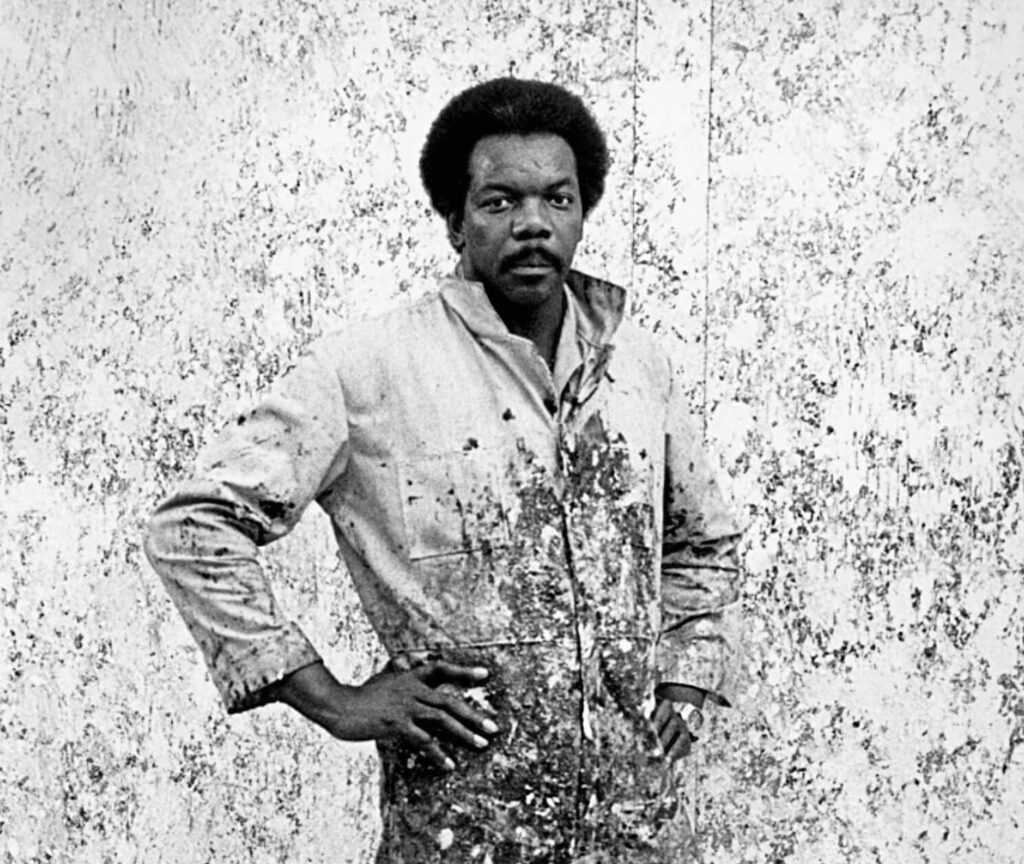Sam Gilliam
Sam Gilliam (1933-2022) was a pioneering American artist who broke boundaries with his innovative approach to abstract art. Known for his vibrant color palette and unique use of materials, Gilliam’s work defied conventional categorization and significantly influenced the evolution of contemporary painting. This biography explores Gilliam’s life, artistic development, and two of his most important artworks, highlighting his enduring legacy.

Early Life and Education
Sam Gilliam was born on November 30, 1933, in Tupelo, Mississippi, as the seventh of eight children in his family. When he was a child, his family moved to Louisville, Kentucky, where he grew up. His early exposure to the rich cultural and musical heritage of the South, combined with his experiences in a segregated society, deeply influenced his worldview and artistic vision.
Gilliam demonstrated artistic talent from an early age and pursued his passion by studying fine arts at the University of Louisville. He earned his Bachelor of Arts in 1955 and his Master of Fine Arts in 1961. During his time at university, Gilliam was exposed to the works of modern European artists and the emerging Abstract Expressionist movement in the United States. These influences would play a crucial role in shaping his unique artistic style.
Early Career and Artistic Development
After completing his education, Gilliam served in the United States Army from 1956 to 1958. Upon his return, he began his teaching career and continued to develop his art. In 1962, he moved to Washington, D.C., where he became associated with the Washington Color School, a movement characterized by its use of bold colors and abstract forms. This period marked a significant turning point in Gilliam’s career, as he began to experiment with new techniques and materials.
Gilliam’s early work was influenced by the Abstract Expressionists, but he quickly developed his own distinct style. He started incorporating elements of Color Field painting, characterized by large areas of unmodulated color, into his work. However, Gilliam’s true innovation came with his groundbreaking approach to the canvas itself.
The Drape Paintings
In the mid-1960s, Gilliam made a radical departure from traditional painting techniques by introducing his “drape paintings.” This innovative approach involved removing the canvas from the stretcher and allowing it to hang freely from the wall or ceiling, creating a three-dimensional, sculptural effect. This technique challenged the conventional boundaries of painting and sculpture, blurring the lines between the two.
Gilliam’s drape paintings were characterized by their vibrant colors and dynamic forms. He used a variety of techniques, including pouring, staining, and folding the canvas, to create rich, layered surfaces. The resulting works were both visually striking and conceptually challenging, as they invited viewers to reconsider the nature of painting and the role of the artist.
Important Artworks
“Carousel Form II” (1969)
“Carousel Form II” is one of Sam Gilliam’s most celebrated works and a prime example of his drape paintings. Created in 1969, this large-scale piece consists of a series of brightly colored canvases that hang from the ceiling, cascading down in fluid, undulating forms. The colors, ranging from deep blues and purples to vibrant yellows and oranges, blend and overlap, creating a sense of movement and energy.
The title “Carousel Form II” evokes the idea of a carousel, a rotating, dynamic structure that brings joy and excitement. This sense of movement and playfulness is reflected in the composition, as the viewer is encouraged to walk around and through the hanging canvases, experiencing the work from multiple perspectives.
“Carousel Form II” exemplifies Gilliam’s innovative use of color and form, as well as his ability to create immersive, experiential artworks. The piece challenges traditional notions of painting and invites viewers to engage with the work in a more interactive and physical way.
“Light Depth” (1971)
Another significant work in Gilliam’s oeuvre is “Light Depth,” created in 1971. This piece is a large, unstretched canvas that hangs freely from the wall, featuring a rich, textured surface of overlapping colors and forms. The composition is dominated by deep blues and greens, interspersed with bright flashes of red, yellow, and white.
The title “Light Depth” suggests a contrast between light and darkness, surface and depth. This theme is reflected in the composition, as the layers of color create a sense of depth and complexity, drawing the viewer’s eye into the painting. The use of light and shadow adds to the dynamic quality of the work, creating a sense of movement and change.
“Light Depth” highlights Gilliam’s mastery of color and his ability to create rich, textured surfaces that evoke a sense of depth and dimension. The piece exemplifies his innovative approach to painting and his ability to push the boundaries of the medium.
Later Career and Legacy
Throughout the 1970s and 1980s, Gilliam continued to experiment with new techniques and materials, expanding his artistic practice to include printmaking, sculpture, and installation art. His work from this period reflects a continued interest in color, form, and space, as well as a desire to challenge conventional notions of art and its presentation.
Gilliam’s contributions to contemporary art were recognized with numerous awards and honors, including a Guggenheim Fellowship in 1971 and a National Endowment for the Arts Fellowship in 1989. His work has been exhibited in major museums and galleries around the world, including the Museum of Modern Art in New York, the Smithsonian American Art Museum, and the Hirshhorn Museum and Sculpture Garden.
Personal Life and Philosophy
Sam Gilliam’s personal life was marked by his dedication to his art and his commitment to social justice. He was deeply influenced by the civil rights movement and often used his work to address issues of race, identity, and inequality. His art was a means of expressing his personal experiences and his vision for a more just and equitable society.
Gilliam viewed his work as a continual process of experimentation and discovery. He believed in the importance of pushing the boundaries of art and challenging conventional notions of beauty and form. His philosophy of art emphasized the importance of color, movement, and space, as well as the need for artists to continually innovate and explore new possibilities.
Legacy and Influence
Sam Gilliam’s legacy as an artist lies in his ability to create a unique visual language that combines color, form, and space in innovative ways. His groundbreaking drape paintings and his continued experimentation with new techniques and materials have left a lasting impact on the field of contemporary art.
Gilliam’s influence extends beyond his own work, as he has inspired generations of artists to push the boundaries of their practice and to explore new possibilities in abstract art. His contributions to the Washington Color School and his innovative approach to painting have earned him a place among the great artists of the 20th century.
Conclusion
Sam Gilliam’s artistic journey is a testament to his creativity, resilience, and profound understanding of color and form. Through his innovative use of draped canvases and his dynamic compositions, he created a body of work that continues to inspire and challenge viewers. “Carousel Form II” and “Light Depth” are just two examples of his ability to convey complex ideas and emotions through abstract forms and vibrant colors. Gilliam’s legacy as a master of abstract art ensures that his work will continue to resonate with audiences for years to come.



